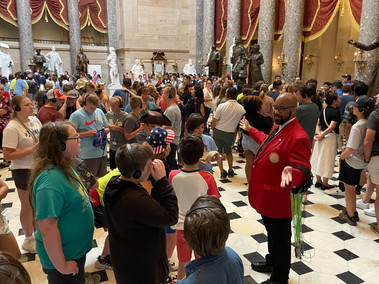Keeping with a 20-year-old Meher School tradition, our recent graduates went on a whirlwind tour of Washington, D.C. As it always is, it was a rich and inspiring experience for all. Students, along with chaperones, parents, and elementary co-principal Vince d'Assis, saw almost two dozen sites, including the MLK Memorial, the JFK Memorial, the Jefferson Memorial, the Albert Einstein statue, Ben's Chili Bowl, George Washington's home at Mount Vernon, the National Archives, the Air and Space Museum, the World War II Memorial, the Korean War Memorial, the Vietnam Veteran's Memorial, the Iwo Jima Memorial, Arlington National Cemetery, Ford's Theater, the Natural History Museum, the American History Museum, the Lincoln Summer Cottage, the African American History Museum, the Native American Indian History Museum, the Hirshhorn Museum, and the Library of Congress.
top of page


















Some two dozen Meher Schools students and parents spent Saturday morning at the White Pony Express distribution center in Pleasant Hill filling backpacks with goods donated by school families in our Baby Backpack Drive.
The volunteers made cards with love notes for the new mothers, which they put in goodie bags filled with chocolate and protein bars. These were included with the other donated items – diapers, onesies, socks, shampoo, blanket, a stuffed animal, and more – they placed in the backpacks.
Kindergarten mom Karina Madrigal, who organized the drive, said, “It was beautiful to see the ripple effect of people engaging in acts of kindness.”

A photo of a lineman on a pole with paper angel wings attached to his shoulders stood out for me on an Instagram page dedicated to kindness. His child worried that her dad’s job was dangerous and created the wings; the dad was touched by her kindness and wears them daily.
How wonderful it is when we show appreciation for children’s caring actions, no matter how small. We want to help them notice and appreciate the kind actions of others. Recognizing instances of generosity, patience, and gentleness increases their well-being and helps them experience the world as a loving supportive place.
Consultant and author Mary Jane Ryan, who coined the term “random acts of kindness,” a term now quoted everywhere, was a parent at our school years ago. Her generosity in offering me encouragement and editorial support for my book The Best Things Parents Do is something I still remember and appreciate. Mary Jane’s concept that we would all benefit if we offered kindnesses randomly, even to strangers, seemed radical at the time. Yet today social media is overflowing with sites that simply document stories of people going out of their way for others they don’t know.
At the end of the school year, it’s nice to help children reflect on the numerous kindnesses they have experienced over the year, stories they can take away with them before they start something new. Create a memory book of kindnesses they can illustrate and look back on in the future. Thinking about these experiences also helps us to understand all the nuanced ways that people can support each other and, at any given moment, show they care.
Here are few examples that come to my mind.
The repeated kindnesses we come to depend on:
All year, not just on special appreciation days, members of the Parent Corral brought flowers and tasty treats to the staff room, buoying teachers’ spirits.
The endless love and kindness flowing from Katie O’Callaghan, our Office receptionist, who treats every tummy ache, scraped knee, and parent concern with palpable compassion and empathy.
The unexpected and surprising kindnesses:
What about the people who spontaneously surprised us with Happiness Day, creating an arbor of yellow balloons and special caring notes for everyone?
Last week preschool parent Beau Bergeron amazed us by creating graphic posters for the school play, even though his daughter is too young to attend.
The new ways children find to support each other:
In recent weeks, third graders playing soccer demonstrated compassion by taking a knee whenever a child fell down during the game.
Earlier in the year, a fifth grader decided to make a friend in every elementary grade so no one would ever feel unfriended.
Examples of kindness, like beautiful shells on the beach, are too numerous to count, but documenting them keeps them alive. Kindnesses often surprise and touch us, but highlighting them helps us internalize the beauty of these interactions so we can make them more commonplace in the future.
bottom of page












































































